Samsung Epic 4G Review: The Fastest Android Phone
by Anand Lal Shimpi on September 6, 2010 5:28 PM EST- Posted in
- Smartphones
- Samsung
- Epic 4G
- Gadgets
- Mobile
Easily Influenced
As the manufacturer for both the NAND that goes into Apple devices and the SoC that Apple uses in the iPhone/iPad, Samsung works closer with Apple than most other smartphone vendors. I was once given a characterization of Samsung that I will never forget: this is a company that’s trying to learn as much as it can from Apple for use in its own smartphone endeavors.
There’s no better example than the Galaxy S. Unlike other vendors who have been Cupertino inspired, Samsung’s learnings are put to use almost exclusively in software. Physically, the Galaxy S is quite dissimilar from the industrial design used in Apple’s iOS products.
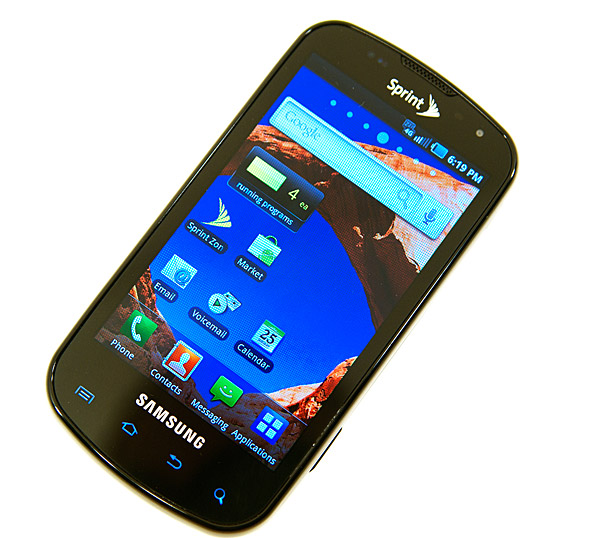
Samsung sent me the Epic 4G, a variant of the Galaxy S for use on Sprint’s network (with WiMAX support as implied by the 4G moniker). The Epic 4G has an amazingly contrasty 4” 800 x 480 Super AMOLED display. The capacitive touchscreen is backed up by a physical keyboard that slides out in landscape mode.
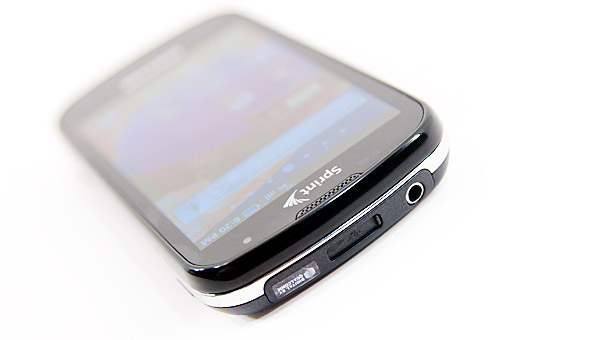
I’d say that Samsung did everything to be the most unlike Apple in the design of the Epic 4G. Along the top you have a microUSB port, but Samsung included a sliding cover to keep the pocket lint out. This adds complexity to the look of the device, but is nicely protective if you’re a bit OCD about getting lint in the crevices of your phone. The sheer location of the microUSB port is unusual as well. Most Android phones we’ve looked at have their power/sync connector at the bottom of the phone, not the top.
The power/lock button also shifts positions compared to what we’re used to. It’s on the right side, near the top on the Epic 4G.
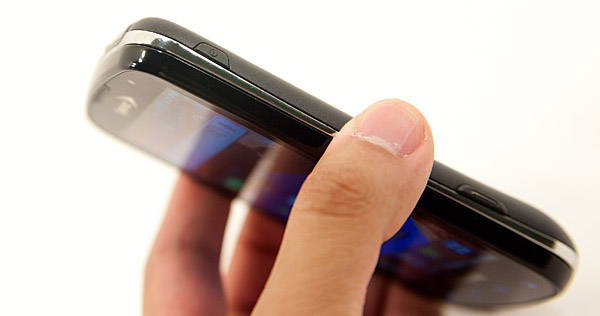
On the lower part of the right side of the phone there’s a shutter release button for the camera. There’s a volume rocker on the left side of the phone. All of the buttons on the Epic 4G have a rubbery texture to them with the exception of the shutter release button which has a metal insert surrounded by rubber.
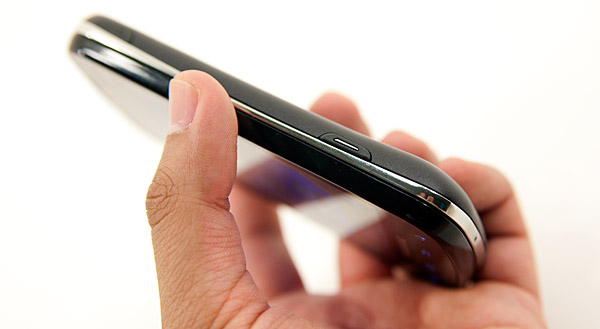
The screen slides up to reveal a landscape keyboard on the Epic 4G. The sliding mechanism is easy enough to operate with one hand and reasonably smooth. It’s not the most confidence inspiring but not terrible either.
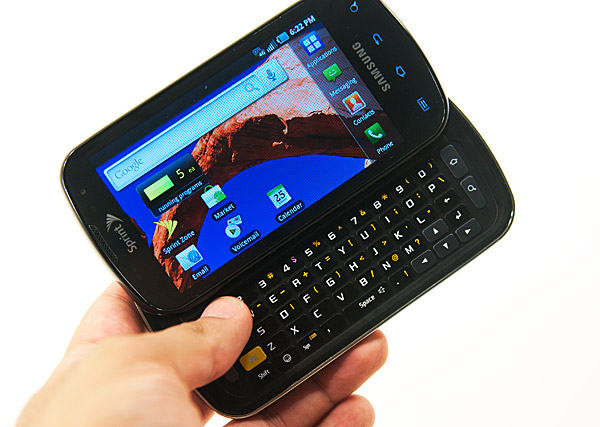
The physical keyboard itself is a nice addition for those who must absolutely have it. Samsung even duplicates the four Android keys on the keyboard itself (home, back, menu, and search) so you can exclusively use the physical keyboard for navigating the OS if you’d like. There is no scroll ball or equivalent on the Epic 4G, but the physical keyboard does have four arrow keys you can use in its stead.
The keys on the physical keyboard are fairly wide and reasonably spaced (it is a landscape keyboard after all). The keys are missing some curved definition that would make it easier to touch type on them but overall it’s not a bad keyboard. Again, not the best I’ve encountered but not terrible at all.
Since this is a slider phone, build quality isn’t the easiest to guarantee. The two halves of the phone independently feel well made, but the joining of the two isn’t super secure. The “oreo effect” as Brian likes to call it is very present on the Epic 4G. You can twist the top and bottom halves of the phone and get them to separate by a couple of degrees. It’s not terrible but if having a loose feeling phone bothers you then you may want to look elsewhere.

The four standard Android keys are also present in capacitive touch form along the bottom edge of the Epic 4G. Unlike most other Android phones, the capacitive buttons aren’t visibly outlined on the phone. You can only see them if they’re backlit, which has a timer associated with it that’s by default separate from the screen timer. What this means is that the row of Android buttons will actually disappear before the screen goes blank if you don’t touch the phone. Thankfully Samsung provides a setting to sync these two so both the screen and buttons go blank at the same time, but it’s just not enabled by default.
The Epic 4G is a good fit in my hand, but with a physical keyboard it is a thicker phone than most I’m used to. If you’re coming from a standard cellphone or feature phone, the Epic 4G is going to feel huge - if you’re coming from another Android/iOS device, it won’t be too bad.

From left to right: Google Nexus One, Samsung Epic 4G, iPhone 4
The phone is a mixture of materials, with the front being glossy plastic, then a chrome strip around the middle and a matte black back cover.
The back cover snaps off with relative ease revealing the 1500mAh battery, a microSD card slot and what looks like four external antenna connectors. I’m not really sure what the exposed connectors are for, perhaps to help during hardware testing/debug. Not having to take the battery out to get to the microSD card is a nice addition as well. The phone comes with a 16GB card as well as a microSD to SD card adapter for use in standard card readers.

Finally on the back we have a lens for the 5MP camera sensor and a single LED flash.
| Physical Comparison | |||||||||
| Apple iPhone 4 | Apple iPhone 3GS | Samsung Epic 4G | HTC EVO 4G | Motorola Droid X | |||||
| Height | 115.2 mm (4.5") | 115 mm (4.5") | 124 mm (4.9") | 121.9 mm (4.8") | 127.5 mm (5.02") | ||||
| Width | 58.6 mm (2.31") | 62.1 mm (2.44") | 63.5 mm (2.5") | 66.0 mm (2.6") | 66.5 mm (2.62") | ||||
| Depth | 9.3 mm ( 0.37") | 12.3 mm (0.48") | 15.2 mm (0.6") | 12.7 mm (0.5") | 9.9 mm (0.39") | ||||
| Weight | 137 g (4.8 oz) | 133 g (4.7 oz) | (5.47 oz) | 170 g (6.0 oz) | 155 g (5.47 oz) | ||||
| CPU | Apple A4 @ ~800MHz | Apple/Samsung A3 @ 600MHz | Samsung Hummingbird @ 1GHz | Qualcomm Scorpion @ 1GHz | TI OMAP 3630 @ 1GHz | ||||
| GPU | PowerVR SGX 535 | PowerVR SGX 535 | PowerVR SGX 540 | Adreno 200 | PowerVR SGX 530 | ||||
| RAM | 512MB LPDDR1 (?) | 256MB LPDDR1 | 512 MB LPDDR1 | 512MB LPDDR1 | 512MB LPDDR1 | ||||
| NAND | 16GB or 32GB integrated | 16 or 32GB integrated | 1 GB integrated, 16 GB microSD preinstalled | 1 GB integrated, 8 GB microSD preinstalled | 8 GB integrated, preinstalled 16 GB microSD | ||||
| Camera | 5MP with LED Flash + Front Facing Camera | 3MP with autofocus | 5 MP with LED Flash and autofocus | 8MP with dual LED Flash + Front Facing Camera | 8MP with dual LED Flash | ||||
| Screen | 3.5" 640 x 960 LED backlit LCD | 3.5" 320 x 480 | 4.0" 480 x 800 | 4.3" 480 x 800 | 4.3" 480 x 854 | ||||
| Battery | Integrated 5.254Whr | Integrated 4.51Whr | Removable 5.55Whr | Removable 5.5Whr | Removable 5.698 Whr | ||||










93 Comments
View All Comments
dvinnen - Tuesday, September 7, 2010 - link
I bet it has to do with the 4G/WiFi-MAX radio. I have a Vibrant and the battery life is fineMilind - Tuesday, September 7, 2010 - link
I think that's possible since my Vibrant gives me about 6-7 hours of battery life with full brightness and the screen consumes about 70-80% of my battery as per the battery usage view. I don't care since I'm typically around a charger so I set it at max brightness. But if I were to lower the brightness, I should easily be able to go for the whole day. Even at 0 brightness, the screen is surprisingly usable.I have also noticed that the only thing that drains battery faster than the screen (in my G1 as well), is if it has to hunt for a phone signal. At one time, my G1 was draining battery in about 2-3 hours, which was awful even by the G1's sorry battery life standard. It turned out to be because I was using a SIM card of a provider that had very poor coverage at the location. As soon as I swapped the SIM with another carrier, the battery life went back up. So it's possible that Sprint's causing the phones to go back and forth between 2g, 3G and 4G signals causing the battery to drain faster. It might be worthwhile to go into the Mobile Networks settings and use only 2G network to check the battery drain. Obviously this would just be to test the hypothesis. It would be stupid to buy this phone and use it only in 2G mode.
jamawass - Tuesday, September 7, 2010 - link
The GPS on my Pre Plus is perfect.Voldenuit - Tuesday, September 7, 2010 - link
Thanks for reviewing the Galaxy S, Anand!Probably the most requested review here. I'm actually glad that the battery life turned out to be abysmal - it helped me make up my mind about an otherwise desirable phone.
Let me explain: My fiancée had two dead Samsung Blackjacks within one warranty period. My Samsung Spinpoint F1 is dying. My mother just junked a dead Samsung TV (5 yrs old). To be perfectly frank, I have ZERO confidence in Samsung products, and the build quality of the Galaxy gives me no reason to revise that opinion.
Fortunately, the poor battery life gives me a legitimate excuse not to buy this, and I won't feel like I am missing out on anything because of a possibly irrational aversion. Sure, it's nice to have a fast phone, but by the time apps come out that make meaningful use of this, there will be *much* faster phones on the market. Buying for future-proofing is not a smart idea in the smartphone space.
Voldenuit - Tuesday, September 7, 2010 - link
PS Still looking for that 'perfect' (Android) smartphone. Evo 4G is too big and power hungry, Droid X plans are too expensive.Something like the recently announced Droid Defy might work, if only it didn't have eFuse, Motoblur, and wasn't tied to a sucky carrier.
I'm perfectly willing to wait 1 year on a post-paid phone plan for a decent phone to come out. Even the Torch would work for me, though probably not for the missus.
First and foremost for me is that it should be a phone above all things and 'smart' second. If you're going to chew the battery life tweeting and watching youtube on it, then have no juice to call AAA when you break down on the highway, it's useless to me. Integration with social apps is also something of a nightmare for me - there are people I may enjoy hanging out with on social occasions, but that doesn't mean I wish to know what they are eating, thinking, drinking or (bodily function deleted) during office hours. Somebody, please get this. So far, only Blackberry seems to. Fortunately, most other BB users are sober/boring enough that BBM is a good way to communicate for the dour, buttoned-down crowd. :p
Mike1111 - Tuesday, September 7, 2010 - link
I think it's worth mentioning that SuperAMOLED is officially a Samsung smartphone exclusive until 2012 (IMHO mostly because of limited AMOLED manufacturing capacity until the new Samsung OLED fab is up and running in 2012) . So you won't see it anywhere else in the near future. So please people, don't bitch about missing Super AMOLEDs in every smartphone that's coming in the next 18 months...Mike1111 - Tuesday, September 7, 2010 - link
Anand, your mixing your SGX versions when mentioning the OMAP3630. One time it's SGX535, the next SGX530. I think SGX530 is correct.Milind - Tuesday, September 7, 2010 - link
>>Thankfully Samsung provides a setting to sync these two so both the screen and buttons go blank at the same time, but it’s just not enabled by default.
>>
I have seen this posted a couple of times, but I can't find any such setting on my Vibrant. Is it on the Epic? Can someone provide a little detail on exactly where this setting is? The timeout for lighting the buttons is just too short and very annoying.
Anand Lal Shimpi - Tuesday, September 7, 2010 - link
On the Epic it's here:Settings -> Sound & Display -> Keyboard timeout (last option in the list) -> Same as screen timeout
Take care,
Anand
Milind - Tuesday, September 7, 2010 - link
Thanks Anand. That option is not present on the Vibrant. The last option on the Vibrant for Sound and Display is TV out. Hopefully, it will be part of the Froyo update.